Lulworth Castle
Lulworth Castle, in East Lulworth, Dorset, England, situated south of the village of Wool, is an early 17th-century hunting lodge erected in the style of a revival fortified castle, one of only five extant Elizabethan or Jacobean buildings of this type. It is listed with Historic England as a Scheduled monument.[1] It is also Grade I listed.[2] The 18th-century Adam style interior of the stone building was devastated by fire in 1929, but has now been restored and serves as a museum. The castle stands in Lulworth Park on the Lulworth Estate.[3] The park and gardens surrounding the castle are Grade II listed with Historic England.[4]
| Lulworth Castle | |
|---|---|
.jpg) Lulworth Castle after restoration | |
| Type | House/castle |
| Location | Dorset, England |
| Area | Purbeck District |
| Built | 1588–1609 |
| Built for | Thomas Howard, 3rd Viscount Howard of Bindon |
| Architect | attributed to Inigo Jones |
| Architectural style(s) | Elizabethan-Jacobean, Adam style interior |
| Governing body | Family owned |
Listed Building – Grade I | |
| Official name: Lulworth Castle | |
| Designated | 30 November 1959 |
| Reference no. | 1323323 |
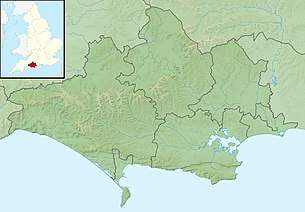 Location of Lulworth Castle in Dorset | |
| Official name | Lulworth Castle |
| Designated | 26 October 1954 |
| Reference no. | 1016069 |
History
The foundations for Lulworth Castle were laid in 1588, and it was completed in 1609, supposedly designed by Inigo Jones.[5] It was built as a hunting lodge by Thomas Howard, 3rd Viscount Howard of Bindon, a grandson of the 3rd Duke of Norfolk. In 1607 Viscount Bindon wrote to Robert Cecil, 1st Earl of Salisbury, crediting him with the origins of the design:
"If this little pile in Lulworth Park shall prove pretty or worth the labour bestowed in the erecting of it, I will acknowledge, as the truth is, that your powerful speech to me at Bindon laid the first foundation of the pile in my mind, which ever since has laboured for a speedy finishing for the contentment of those for whose further liking of that place the care is taken".[6]
According to the NHLE listing, the building was subsequently remodelled 1609-11 for Thomas, Lord Suffolk; remodelled again in 1641 for Humphrey Weld; in the early 18th century by the Bastard brothers of Blandford Forum; and in the 1780s by Catholic architect John Tasker for Thomas Weld. Tasker also built the Roman Catholic chapel in the grounds. Pevsner's assessment of the castle building two hundred years later views it as a Jacobean case of one-upmanship among wealthy landowners whose residential needs are already satisfied elsewhere, hence a series of " 'mock castles', such as the Elizabethan castellated house par excellence that is Longford Castle" which probably inspired Bindon.[7]
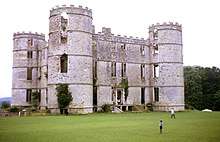
In 1641, Humphrey Weld, a grandson of Humphrey Weld (died 1610), purchased it from Howard's heir, Lord Howard de Walden. The castle was seized by the Roundheads during the English Civil War, who used it as a garrison. Weld regained the property after the war finished. Thomas Weld inherited the property after his older brother, Edward, died in a riding accident in 1775. Twenty-five-year-old Thomas set about refurbishing the interiors in the Adam style. He assembled there a rich collection of books in the magnificent library, a few of which are extant.[8]
Following the French Revolution, the surviving members of the French royal family were invited to use Lulworth as one of their residences-in-exile. Later Charles X of France and family also stayed there briefly, following the July Revolution of 1830 on their way to Edinburgh.[9]
St Mary's Chapel, Lulworth
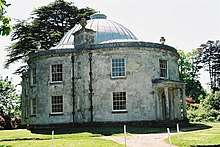
Thomas Weld built a Roman Catholic church dedicated to St. Mary's to serve as the family chapel in the grounds of the castle in 1786. Pevsner relates that he needed permission from King George III on condition that it did not look like a church from outside. It was to be the first Roman Catholic chapel to be built in England since the time of the Protestant Reformation. It was designed by John Tasker in the form of a Greek mausoleum at a cost of £2,380.[7] The building has been Grade I listed.[10]
On 15 August 1790 John Carroll, an "American" Jesuit friend of Thomas, was consecrated bishop by Bishop Charles Walmesley, in the chapel of Lulworth Castle. Carroll was later to become the first Roman Catholic archbishop of Baltimore.[11] The next episcopal consecration took place there on 19 December of the same year when John Douglass was consecrated bishop of The London District (which included the home counties, the West Indies with the exception of Trinidad, and the Channel Islands of Jersey and Guernsey) by William Gibson, titular bishop of Acanthus, and Vicar Apostolic of the Northern District.[12] After his sudden death in Stonyhurst in 1810, Thomas Weld was buried in the Lulworth chapel crypt.[13]
Restoration
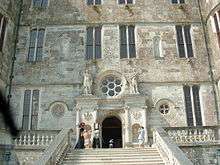
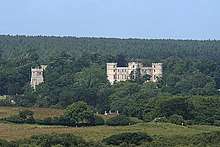
The castle was gutted by fire on 29 August 1929[14] and was left as a roofless ruin, the family building a new residence for themselves nearby. In the 1970s, restoration work began with the help of English Heritage. The restoration, finished in 1998, included a new roof and restored surviving walls in the interior, but no new internal walls or replacements for the destroyed upper floors were constructed.
In 1986 the Baltimore-born organ builder William Drake restored the 1780 Seede organ at the Roman Catholic Chapel at Lulworth Castle, a project that attracted attention internationally.[15]
The castle is still owned by the Weld family[16] and is a tourist attraction, holding medieval-themed events. Part of the Lulworth Estate is in use as an MoD firing range as well as a wildlife conservation area.
Since 2017, the site has been used as the location for the Bestival music festival, with the castle's foreground being the location for the main "Castle" stage.
References
- Historic England (26 October 1954). "post medieval hunting lodge (1016069)". National Heritage List for England.
- Historic England. "Name: Lulworth Castle (1323323)". National Heritage List for England. Retrieved 7 May 2020.
- "About the Estate". Lulworth, Dorset Estate. Retrieved 23 November 2017.
- Historic England. "Park and gardens Name: Lulworth Castle (1000720)". National Heritage List for England. Retrieved 7 May 2020.
- Hutchins, John (1861). The History and Antiquities of the County of Dorset. 1. Westminster: John Bowyer Nichols and Sons. p. 374.
- HMC 9 Salisbury Hatfield, vol. 20 (London, 1968), p. 204.
- Newman, John and Pevsner, Nikolaus (1972). "East Lulworth". Dorset Buildings of England - Pevsner buildings of England. The Buildings of England, Ireland, and Scotland Series. Yale University Press. p. 194. ISBN 978-0-3000-9598-2.CS1 maint: uses authors parameter (link)
- Akira, Hirano (2013). "Treasures of the Library". The Sainsbury Institute for the Study of Japanese Art and Culture - University of East Anglia. Retrieved 5 May 2020.
- Nagel, Susan (2008). Marie-Thérèse: The Fate of Marie Antoinette's Daughter. Bloomsbury. pp. 322–323. ISBN 978-0-7475-8159-8.
- Historic England (20 November 1959). "Roman Catholic Chapel of St Mary, Lulworth Park (1323322)". National Heritage List for England.
- The American Catholic quarterly review, Volume 14 Lulworth Chapel, Bishop Carroll and Bishop Walmesley
- Ward, Bernard. Catholic London a Century Ago, Catholic Truth Society, 1905, p. 62
- "Thomas Weld". Find a Grave Memorial. Retrieved 5 May 2020.
- "Lulworth Castle exhibition will recall a fateful day". Bournemouth Echo. 31 August 2009.
- "The National Pipe Organ Register - NPOR". npor.org.uk. Retrieved 21 August 2019.
- "James Weld: keeping it local". Dorset Magazine. 27 April 2009.
Bibliography
- C. M. Antony. "Lulworth Castle: Its History and Memories." The Catholic Historical Review, Vol. 1, No. 3 (Oct., 1915), pp. 243-257
- Berkeley, J. Lulworth and the Welds. Gillingham: Blackmore, 1971.
- Manco, Jean, Greenhalf, David and Girouard, Mark. "Lulworth Castle in the Seventeenth Century". Architectural History, Vol. 33, (1990), pp. 29-59.
- Manco, Jean and Kelly, Francis. "Lulworth Castle from 1700." Architectural History, Vol. 34, (1991), pp. 145-170
- The Weld family & Lulworth. Wareham: Lulworth Castle. 2004.
- Newth, John. "One of Dorset’s grandest and most interesting country houses - The history of Lulworth Castle is bound up with the stories of the Weld family and of one of the most important estates in South Dorset. John Newth has been to visit.". Dorset Life, April 2015. Wiew on line:
Gallery
 Lulworth Castle in the park
Lulworth Castle in the park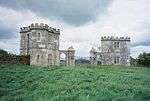 Lulworth Castle, Triangular Lodges
Lulworth Castle, Triangular Lodges.jpg) Lulworth Castle stables (1932)
Lulworth Castle stables (1932) Roof from interior
Roof from interior Castle Interior
Castle Interior Castle kitchen
Castle kitchen Castle vaulted cellar
Castle vaulted cellar